How We Took Degraded Land in the Western Ghats & Turned It Into a Thriving Forest in Just 7 Years
A seven-year experiment that planted 100 native tree species and helped restore the ecology around a small patch of degraded land in the Western Ghats is proof that there are endless possibilities for conservation.
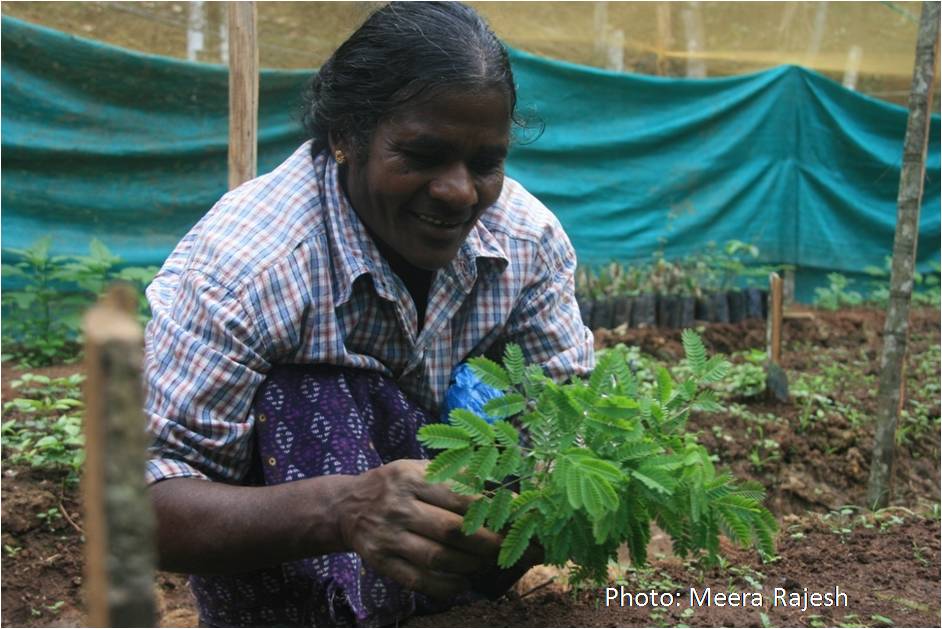
The land transformation journey of Forest First Samithi by conserving biodiversity, planting 100 endemic tree species of Western Ghats, restoring its ecology, harvesting rainwater and converting a degraded land invaded by Lantana.
Wayanad on the Western Ghats, home to river Kabini, one of the main tributaries of river Cauvery, is fast losing its’ endemic trees both inside and outside the forests. As much as 40% forest land is teak, eucalyptus or silver oak plantations. Landscape outside the forest has been highly altered by cutting down the endemic trees of Western Ghats vital to the rich floral diversity, soil fertility, water retention and perennial nature of its’ streams.
Conserving the endemic trees of Western Ghats on that landscape is no more a choice – it is the only way forward to ensure sustenance of floral diversity that is vital to our food and water security.
The journey on a small 8-acre land gives the multitude options any farmer can adopt in this area by leaving 10% of their land for “farm groves”.
Farm Groves: Integrated Farming with Forest Groves
In 2008, when a degraded farm land of 8 acres with hardly 10 trees was bought, the vision was very clear – afforest. The vision was to leave one part of the farm as forest patch enabling biodiversity conservation.
The land has steep slopes of 45 degrees and is in between two hills. Before the process of afforestation started, the land was losing most of its top soil during the peak monsoon. The farm was southwest-facing and the harsh rays of the sun would just crack the soil during summer. The effects of these extreme conditions, with less shade and extreme exposure to rain and sun, was twofold – Lantana camera ( an invasive weed) proliferation and top soil erosion during monsoon. The farm had to spend Rs.30,000 every year to clear Lantana. The rain would bring all the top soil down and one could see red water flowing out of the land during heavy rains.
The solution was obvious – bring shade, bring biomass, hold the top soil – and only trees could do this effectively.
Sitting on the eastern side of Wayanad, on the slopes of Western Ghats, the farm was witnessing fast depletion of endemic tree species of Western Ghats. Their neighboring farmlands were a monoculture of exotic silveroak and the landscape lost its’ endemic trees to the timber lobby every summer.
The disturbing sound of the saw machines cut through one’s heart during the months of April and May in Wayanad. Truckloads of trees get chopped from the area. It made it clear that we needed to conserve a germplasm of endemic trees of Western Ghats for posterity.
 Yearly logging, growing coffee by clearing native trees is a common practice in Wayanad
Yearly logging, growing coffee by clearing native trees is a common practice in Wayanad
In search of endemic trees
The Forest First Samithi’s team was exposed to several research reports on the local and endemic trees of the region. Their challenge was to procure these tree species. Their search gave an exposure to several nurseries and institutes that conserve these tree species. Their planting started in year 2009 and they conserved over 100 species of trees by planting over 5 years till 2014. This included several species of rare, endangered and threatened species native to the Western Ghats. Some years, their survival rates of saplings planted were 60% and some years they saw 90% survival rates.
 In-situ nursery setup ensuring the saplings are acclimatized with the local microclimate before planting
In-situ nursery setup ensuring the saplings are acclimatized with the local microclimate before planting
The land transformation
Eight years of this consistent land transformation effort resulted in one of the finest creations. Over 100 species, roughly 3,000 saplings, in 8 acres of land. In three years, Lantana management was completely eliminated by these techniques: Planting gliricedia for biomass and banana as intercrop with minimal maintenance. These two methods brought in the necessary shade needed for the saplings to thrive during the harsh summer. The banana intercrop gave small economic benefits to sustain two women on the farm throughout the year.
Rainwater trenches were dug all over the contours in 2012-13 and gliricedia was planted on the bunds. This was much needed to ensure local water percolation and improve the micro climate. In some steep slopes, vetriver was also planted to hold soil.
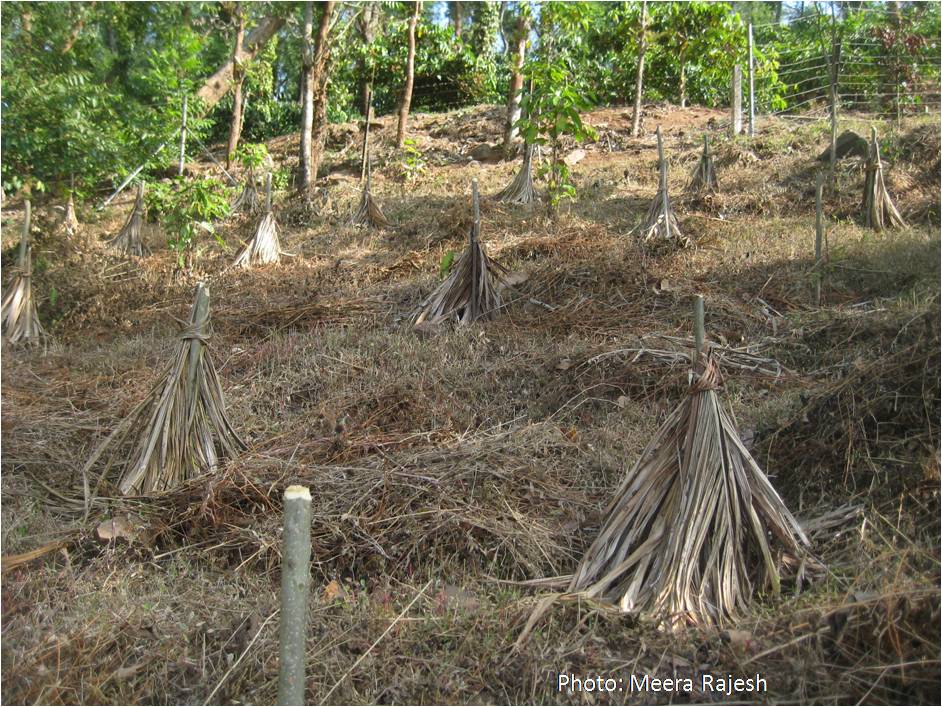 Clearing lantana, dealing with harsh sun during summer and steep terrain. The slopes were exposed to sun before starting the grove
Clearing lantana, dealing with harsh sun during summer and steep terrain. The slopes were exposed to sun before starting the grove
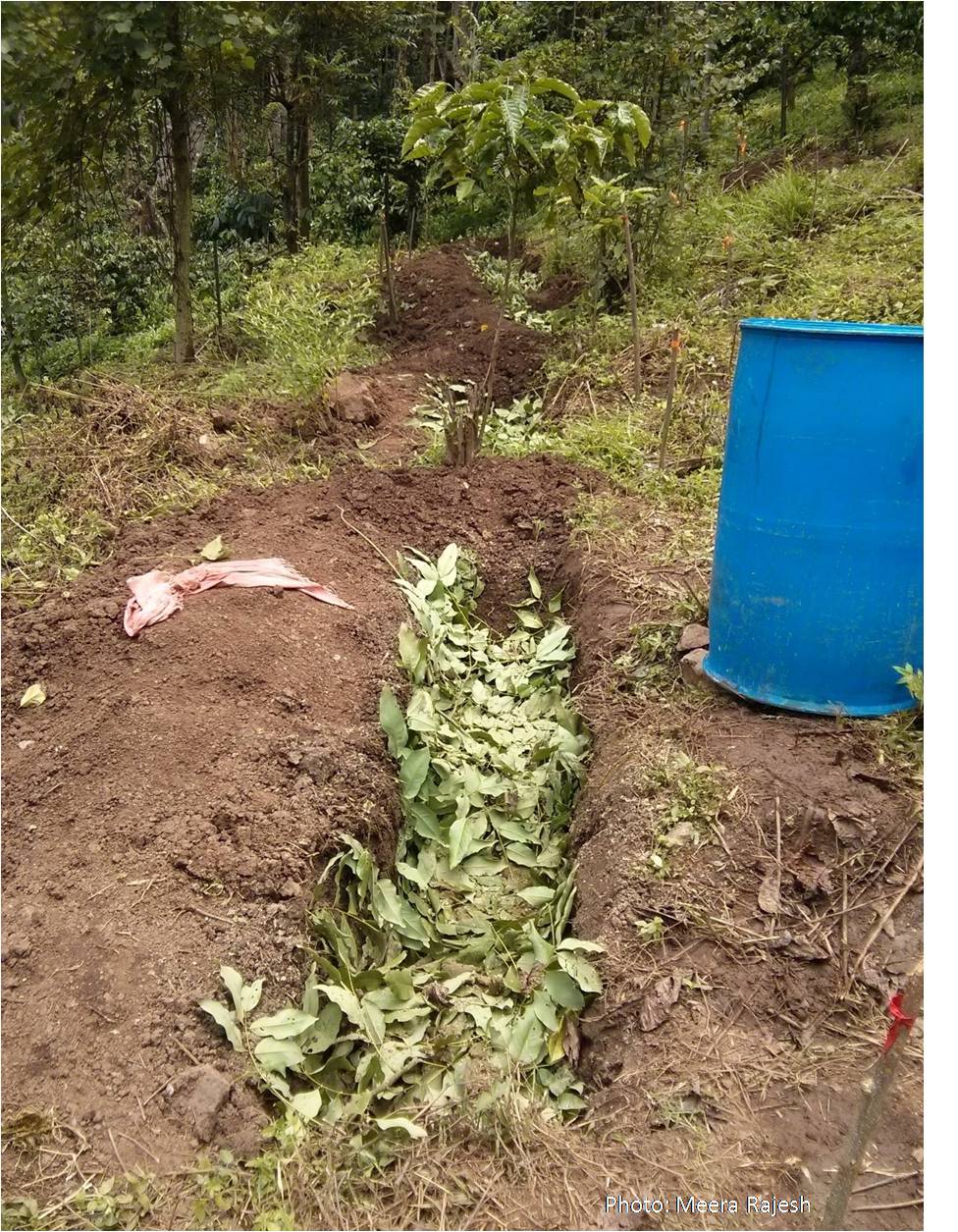 Rainwater trenches all over the land – Smaller trenches of 2 ft deep and 6 ft long and 2 ft wide would cost Rs.500 per trench and deeper trenches of 4ft deep, 3 ft wide, 6 ft length would cost Rs.1000 per trench
Rainwater trenches all over the land – Smaller trenches of 2 ft deep and 6 ft long and 2 ft wide would cost Rs.500 per trench and deeper trenches of 4ft deep, 3 ft wide, 6 ft length would cost Rs.1000 per trench
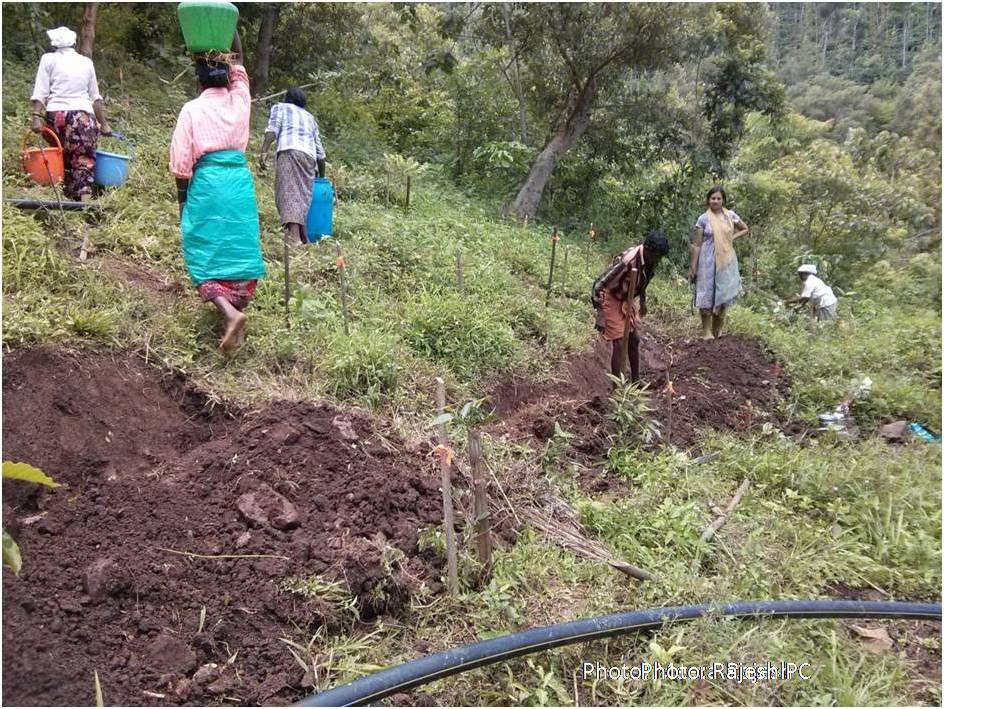 Working on steep slopes
Working on steep slopes
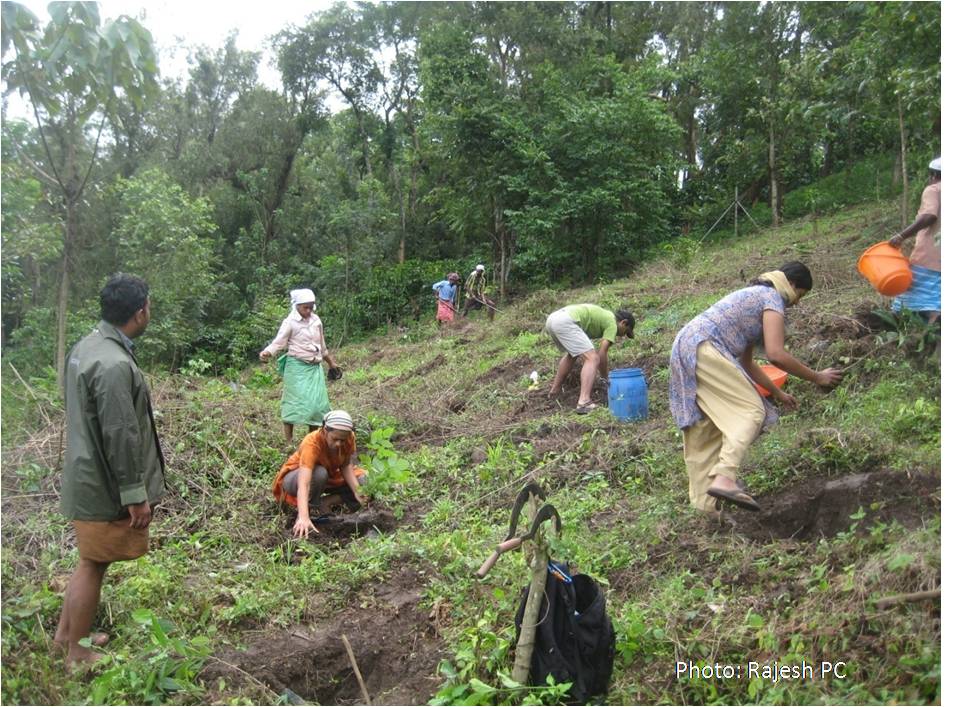 Planting only during peak monsoon
Planting only during peak monsoon
The labour force was asked to stop clearing biomass around coffee plants. The idea of “chop and drop” from permaculture was borrowed that ensured soil is kept intact and grass and weeds were cleared without disturbing its roots.
Two native cows as addition on the farm enhanced the manuring on the land by preparing jeevamrita. Jeevamrita application has become a weekly habit, applied area wise on the rain water trenches for intercropping coffee, pepper, lemon, oranges and banana to thrive.
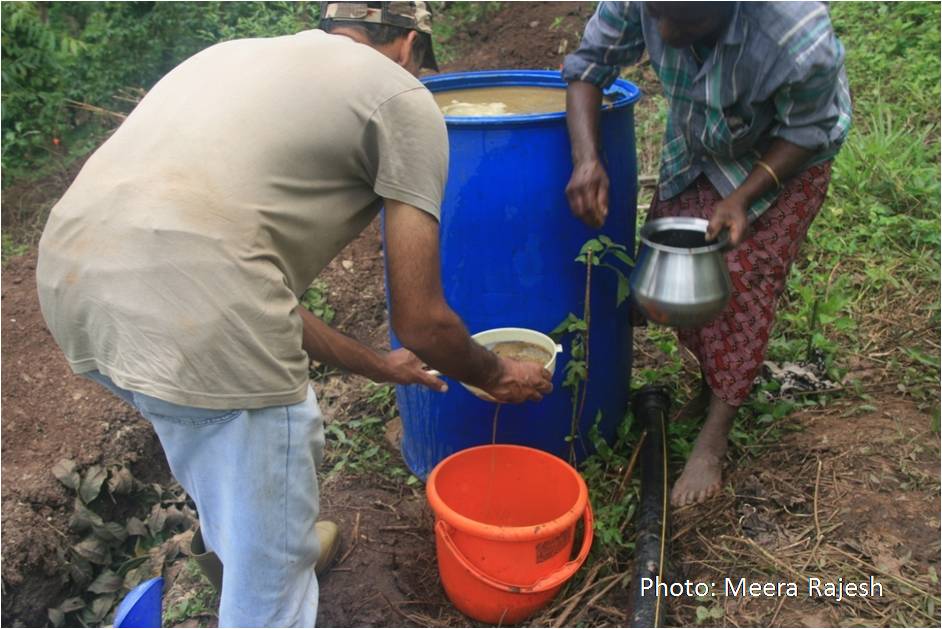 Jeevamrita as manure
Jeevamrita as manure
Many Ficus species were planted and this started seeing a growth in bird diversity on the land. Butterfly host plants were planted intermittently for attracting pollinators. The tree stumps and gliricedia stumps would attract owlets as effective pest controllers. The bat population also increased by the sustenance of Ficus trees on the land. The spot was soon becoming a hotspot of birds, frogs, butterflies, bats and snakes apart from the 100 odd tree species.
The biggest surprise factor in these seven years of effort was the presence of leeches on the land during monsoon. The land was finally showing signs of retaining moisture and the rainwater no longer looked red. Soil biomass was improving with the leaf litter from the trees that were fast growing. The team was witnessing the process of land transformation.
Ecological Services
The neighbouring farmers thought the two were out of their mind for planting forest species. Many discouraged them from planting Ficus on farm land. They were well-meaning and experienced neighbours. They knew the local farmers’ traditional knowledge had been intercepted by over 40 years of chemical farming. The best the duo could do was to listen and take the knowledge of planting, lunar calendars and integrate with their knowledge of natural farming and permaculture.
The forest grove on the highest point of their land is an effective water retention unit, biomass provider, haven for predator species to do effective pest control, home for pollinators to serve the land. All these come at zero cost over time.
 Farm Grove Forest Canopy in 8 years of planting and maintenance
Farm Grove Forest Canopy in 8 years of planting and maintenance
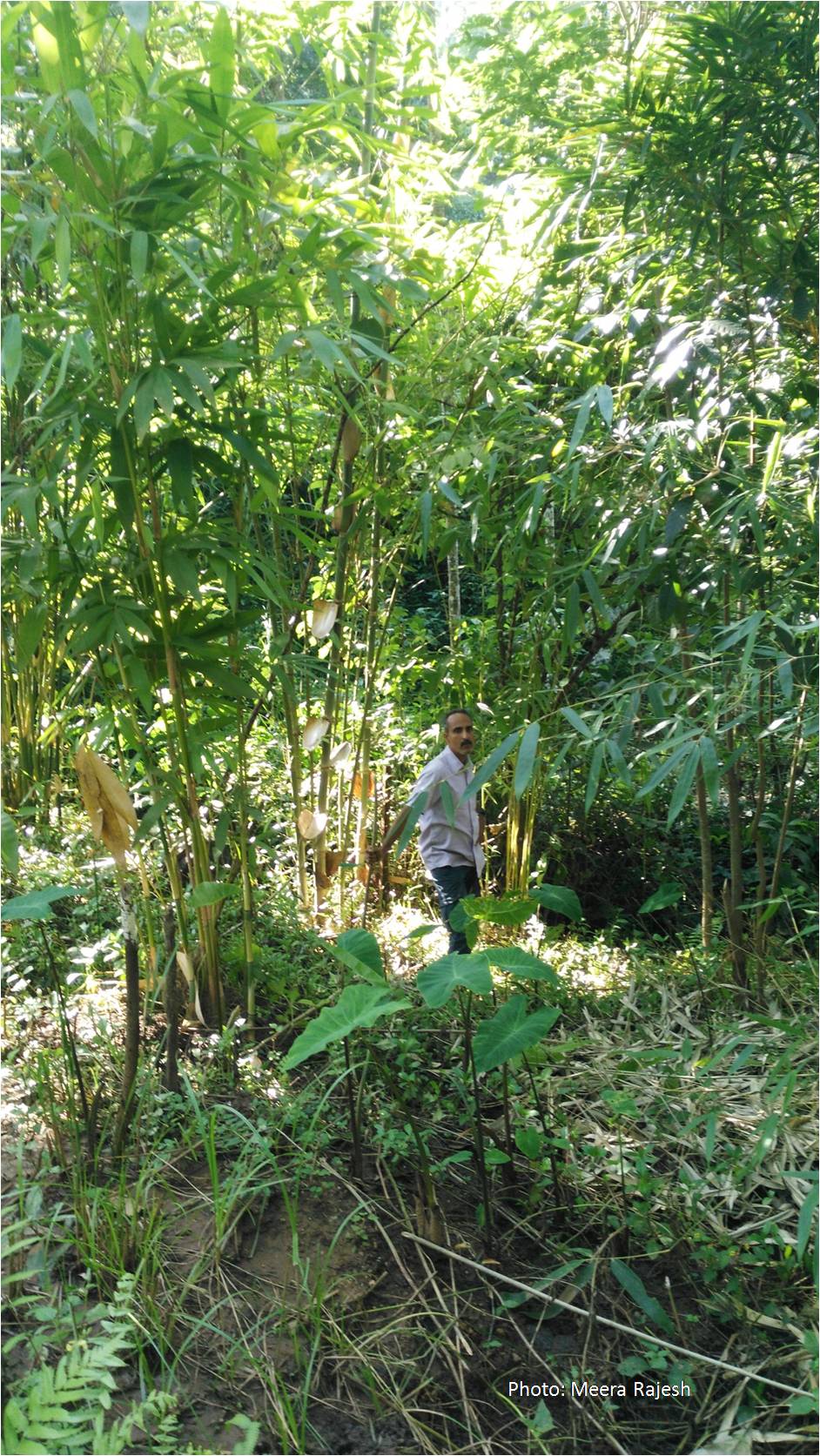 Bamboo patch created next to a stream , growth in 3 years
Bamboo patch created next to a stream , growth in 3 years
Endless possibilities
There are many aspects of farming one can integrate with tree species in the landscape. Pepper is an effective intercrop with trees and shade. One can plant tubers in area where saplings are growing by securing the patch from the attack of wild boars. Herbs that are economically viable in ayurveda can be grown as an intercrop with tree saplings. Banana intercropping with tree planting will create a cool micro climate for the endemic saplings to thrive. Some of the tree species are also economically important non-wood species , example the triphala species of Terminalia chebula (Haritaki), Terminalia bellirica(Bahera), Embillica officinalis (Amla).
Monetary benefits need not come only from wood. Groves need to be looked at from its’ ecological services and every farm can afford to set aside 10% of the entire land for sustenance of these ecological service. Forest tree conservation must be done beyond the boundaries of forests and policy changes must bring in support mechanisms for conserving groves in farmsteads for the food security of the nation.
About Forest First Samithi
Forest First Samithi is a registered society focusing on biodiversity conservation by conserving endemic trees of Western Ghats and ensuring species diversity. Forest First Samithi has transformed part of several farms to include farm groves. Presently Forest First Samithi is transforming a 60 acre land in Kodagu inside an institution.
The Forest First Samithi family has grown from four crazy people who wanted to conserve biodiversity to include 10 permanent members, close to 30 volunteers, 5,000 endemic trees growing voraciously, one naati cow called Parvathy, a bull called Shankar, some peacocks, a barking deer, wild boars, rabbits, many species of birds, frogs, bats, butterflies and some leeches. The family continues to grow everyday. Want to be a part of this excitement, write to us at [email protected] or http://www.forestfirstsamithi.org/ https://www.facebook.com/forestfirstsamithi?fref=photo
Like this story? Or have something to share? Write to us: [email protected], or connect with us on Facebook and Twitter.
NEW: Click here to get positive news on WhatsApp!
This story made me
- 97
- 121
- 89
- 167
Tell Us More
We bring stories straight from the heart of India, to inspire millions and create a wave of impact. Our positive movement is growing bigger everyday, and we would love for you to join it.
Please contribute whatever you can, every little penny helps our team in bringing you more stories that support dreams and spread hope.



















